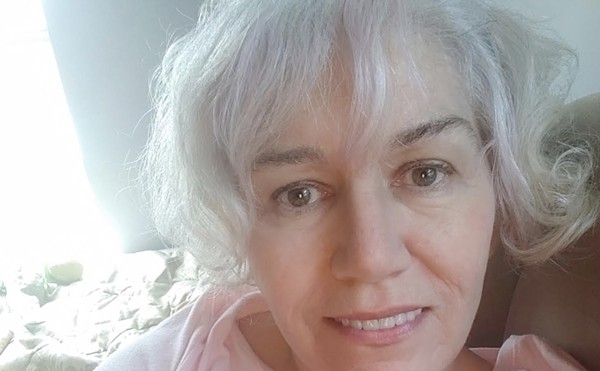Several years ago Rebecca Rentz sat through the kind of meetings that most citizens dread. The city wanted to know how best to change the blighted Parramore neighborhood, arguably the most-discussed community in Orlando because of its high crime rate and close proximity to downtown.
At the end of the meeting, the city's paid consultant unveiled the grand plan: The city should pay to put picket fences in front of the shotgun shacks and modest homes in the mile-long community. The consultant even took pictures of houses and superimposed picket fences over them.
"It was an absolute joke," says Rentz, a 39-year-old College Park realtor.
Rentz is among a small group of Parramore landowners who claim to have a better idea how Parramore should develop. The group, all of whom own property on West Amelia Street, say that the city should loosen its grip on its land-use and zoning laws to allow high-rise buildings and commercial zoning in the northern part of Parramore, between West Colonial Drive and Robinson Street, Parramore Avenue and Westmoreland Drive.
"My dream, obviously, is for all this property to be developable so we can all benefit in some way," says Rentz, whose family has owned a number of Parramore homes and businesses since the 1920s.
But the neighborhood continues to resist the kind of private development currently shaping the downtown skyline on the opposite side of I-4. The crime rate is mostly to blame, but other factors contribute. Inconsistent zoning patterns mean that recycling plants, gas storage facilities and auto body shops sit on the same street as houses and small stores. Compounding matters is the Coalition for the Homeless, an emergency shelter for hundreds who sleep inside at night and loiter outside during part of the day; once seen as a downtown necessity, it is now viewed as an impediment to progress.
Parramore needs a grocery store, doctors offices, and small retail businesses and restaurants. Before that happens, however, businesses want to see a greater population density, which means more homes. Yet building homes is only part of the problem. The other is maintaining them. Low-income residents have a difficult time keeping up properties. That becomes evident as you drive around Parramore and see the dilapidated or boarded up Habitat for Humanity homes.
The city's strategy has been to focus on residential property. Conventional wisdom holds that homeowners are more likely to be more socially responsible than tenants. Yet more than 90 percent of Parramore's 6,000 residents are renters.
The city's Community Redevelopment Agency (CRA), an independent branch of Orlando government, spent several million dollars subsidizing 23 homes in the north part of Parramore, on Arlington and Concord streets. It spent another million buying homes several blocks away for a development of $150,000 homes called Pepperhill, a name borrowed from a previous Parramore subdivision.
Between these two subdivisions is West Amelia Street, home to 20 businesses, including a band rehearsal studio, a day-labor pool, an auto body shop and an interior design office. The CRA's "vision" for this one-block industrial area was to persuade property owners to sell their land to the city, which would then build a residential development. The proposed housing would have made a contiguous residential area from Colonial Drive south to Michigan Street, except for commercial areas along a few main arteries.
But the CRA blundered as it moved forward with the idea. CRA employees didn't notify Amelia Street property owners of the city's new "vision." In a heated confrontation last year, the CRA's executive director, Tom Kohler, backed away from the plan and agreed to work with property owners to mesh residential and industrial areas.
This summer, the CRA spent $30,000 for two planning firms to host workshops, surveys and interviews, ostensibly to build consensus among various stakeholders. But in a sign of how difficult it is to bring competing interests together in Parramore, landowners, homeowners, tenants and CRA officials came away more divided than when they began.
The West Amelia Street landowners make a number of allegations. They say the study was tainted by consultants and experts Ã? some of whom were city employees Ã?Ã?who emphasized that residential was a better fit than high-rise commercial for north-Parramore area.
Additionally, Joe Gray, the moderator of the workshops, didn't allow debate during the forums. Instead, the sessions broke into groups, which then went through exercises such as choosing between pictures of residential property. Gray angered landowners when he encouraged tenants from outside the study area to join the group; landowners had been promised in writing that they would be the focus of the study. Indeed, last year during a heated meeting in Parramore, District 5 City Commissioner Daisy Lynum said she'd rather work with property owners because tenants constantly change.
From the landowners' perspective, the study was a waste. "I've been to these neighborhood meetings before," says Gary Doane, another Parramore property owner. "They are so bogus it's pathetic."
CRA director Kohler, who surprised City Hall by announcing his resignation last week, is adamantly opposed to building high-rises (defined as buildings taller than seven stories) along Amelia Street. "You want that area to stagnate? Put a zoning category there that the market won't respond to," he says. "Nothing will happen there, period. Look at downtown. Ninety-nine percent of it isn't over `seven-stories` high."
Joe Gray says he's talked to investors, bankers and developers who have told him the same thing: They're not interested in building high-rises in the 900-acre blighted community. "I brought that up to the attorneys for one of the banks and he almost laughed himself out of his office," Gray says. "We can't sacrifice the entire community over there just because a couple of people think they can make money."
Kohler blames one of the Amelia Street property owners, David van Gelder, for pushing forward with the idea of high-rise buildings on West Amelia Street and causing tension. "This plan has been consistent since the early '70s," says Kohler. "Just because Mr. van Gelder has a personal vendetta against `CRA assistant director` Joyce Sellen and me, that's not the way public policy is made."
Kohler is correct that van Gelder, a 45-year-old Orlando native, has been a thorn in the city's side. He e-mails a constant stream of criticisms, allegations and political cartoons to thousands of Central Florida residents, many of whom work in government. He's also a regular at council meetings and is a frequent critic of the city on Doug Guetzloe's radio talk-show program.
But if van Gelder is a monster, it was the city who created him. Van Gelder wasn't involved in city politics until he discovered second-hand the CRA's scheme to buy and rezone the West Amelia property, which enraged other Parramore property owners.
Indeed, it was the CRA's willingness to downzone Amelia Street property that provided van Gelder with an opportunity to upzone. "I always knew downtown would grow west," van Gelder says. "I wasn't ready to act right away. What instigated my move was them coming to downzone my property."
Van Gelder's argument for high rise is based on the fact that six buildings as tall as nine stories sit within 1,800 feet of his property, including the T.D. Waterhouse Centre and the Educational Leadership Center, home to Orange County Public Schools. West Amelia Street is an extra-wide street located close to Interstate 4, Orange Blossom Trail and West Colonial Drive. As property values there increase, tax money could be set aside for low-income residents to relocate. And the zoning on West Amelia already allows seven-story buildings. If a developer is willing to go seven stories, why not higher? "Let the market dictate what happens here," he says.
Van Gelder is joined by property owners with impressive credentials. They include Alan Altshuler, a real estate broker at Major Realty in the mid-1970s when city Commissioner Don Ammerman worked there as a real estate agent. Altshuler owns a 120,000-square-foot warehouse (nearly three acres under roof) near Orange Blossom Trail and West Colonial Drive. His hope is that the warehouse will one day become a skyscraper that will dwarf Orlando's tallest building, the 30-story SunTrust Center.
Another realtor, Bruce McCall, inherited property his family has owned in Orlando for more than 50 years. Helen M. King is a 94-year-old widow who owns 6.75 acres of land, half of which is undeveloped. John Milner, an electrical parts wholesaler, owns a 50,000-square-foot warehouse leased to Hughes Supply.
Each has been waiting for downtown to expand west, especially since land values to the north, south and east of downtown make development more expensive in those areas. "The possibilities are endless here," McCall says.
The traditionally African-American community in Parramore has mixed reaction to high-rises on Amelia. Van Gelder received a bad review from the Callahan Neighborhood Association last week. But other leaders of the black community seem agreeable. "Amelia Street could be the Main Street in this community," says Carl Lancaster, a deacon at the Mt. Zion Baptist Church.
The landowners are ready to expose the city's policy flaws. On one hand, the city says it has pledged to build housing based on feedback from Parramore constituents. On the other, when a real estate investment firm -- the Charlotte, N.C.-based Carolina-Florida Properties -- began assembling properties three blocks west of City Hall, the city made only tepid attempts to halt the demolition of dozens of houses. The city gave Carolina-Florida preferential treatment, swapping property with the company so it could complete its assemblage and offering a sweet zoning deal. But the Carolina-Florida deal has stagnated because the company can't find a developer. City officials aren't sure when, or if, the property will develop.
Yet West Amelia Street landowners also face a fight with residents of Arlington and Concord streets, who don't seem agreeable to high-rises in their back yards. The landowner group's response: Upzone the area to commercial so doctors and lawyers can move into the homes, similar to the low-density offices east of Lake Eola in the increasingly upscale Thornton Park area.
Some homeowners don't like that solution, either. "I have a 1925 bungalow," says Sara Manthey, the Arlington-Concord Neighborhood Association president. "I could sell it to an accountant for big bucks. But it's not about the money."
Look for landowners, homeowners and tenants to continue their battle as the Amelia Street study winds through city government. Landowners are also prepared to make an end-run around the CRA by spending $5,000 to begin the re-zoning process. Failing that, they say they will consider suing the city in Orange County court.

















